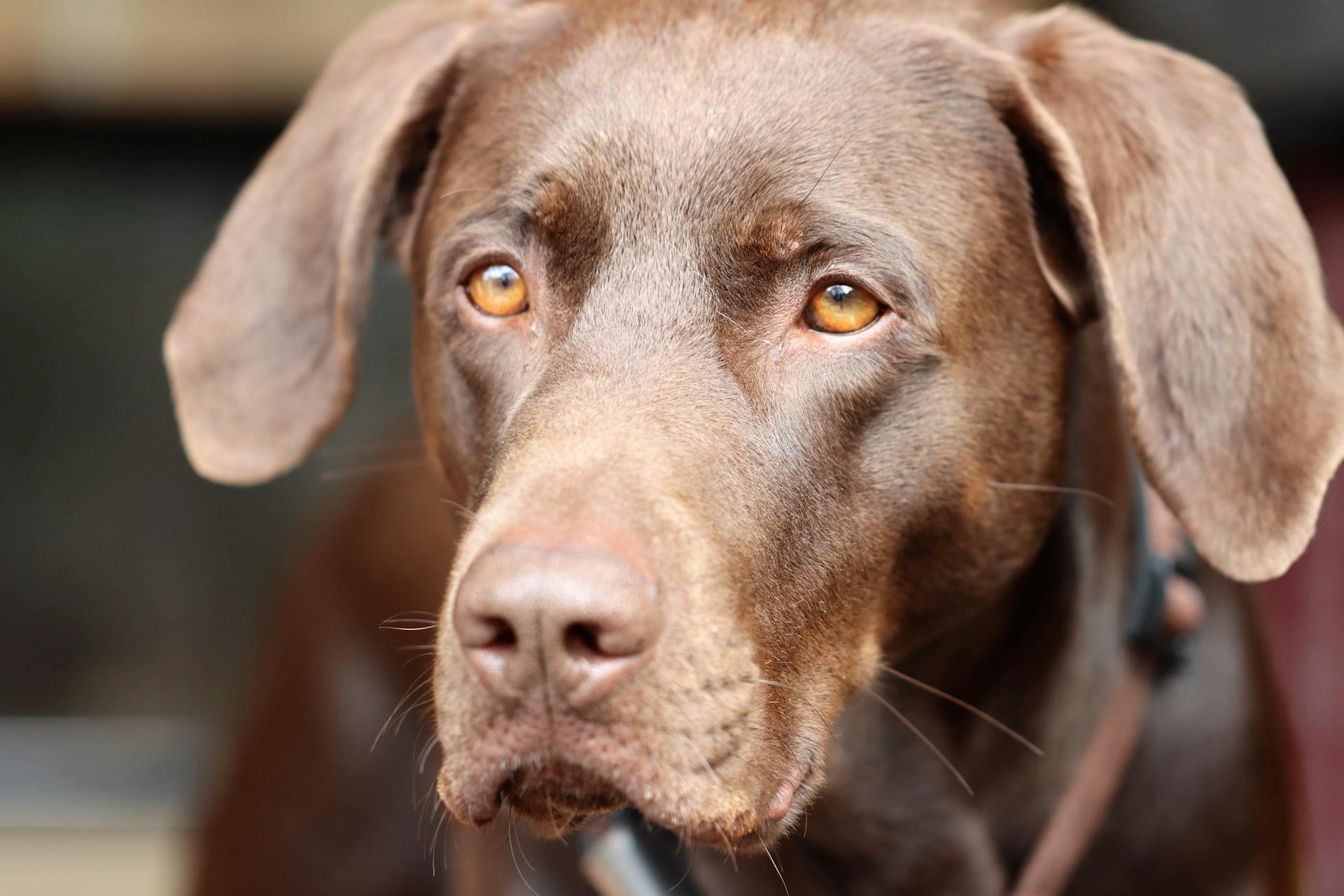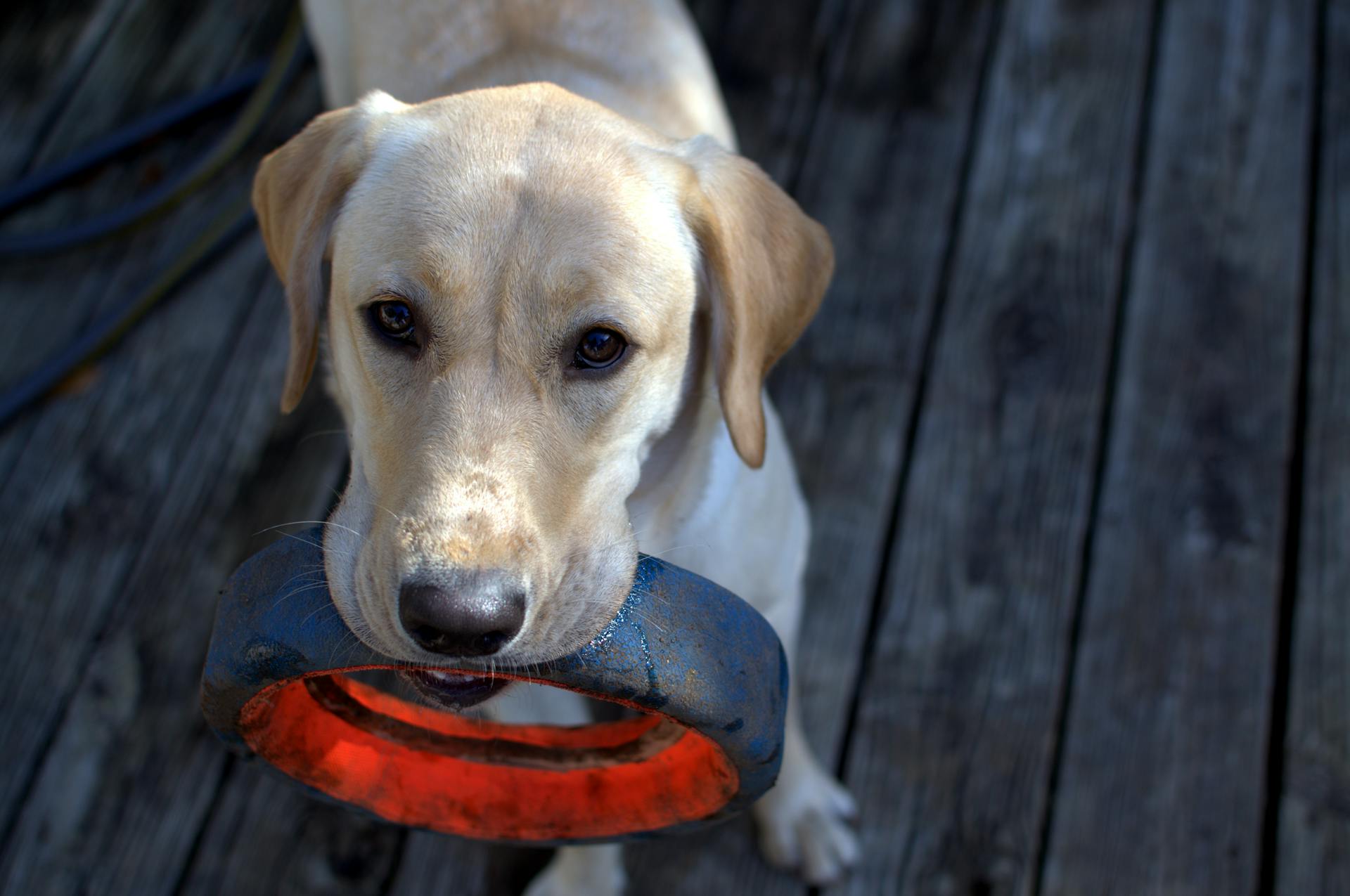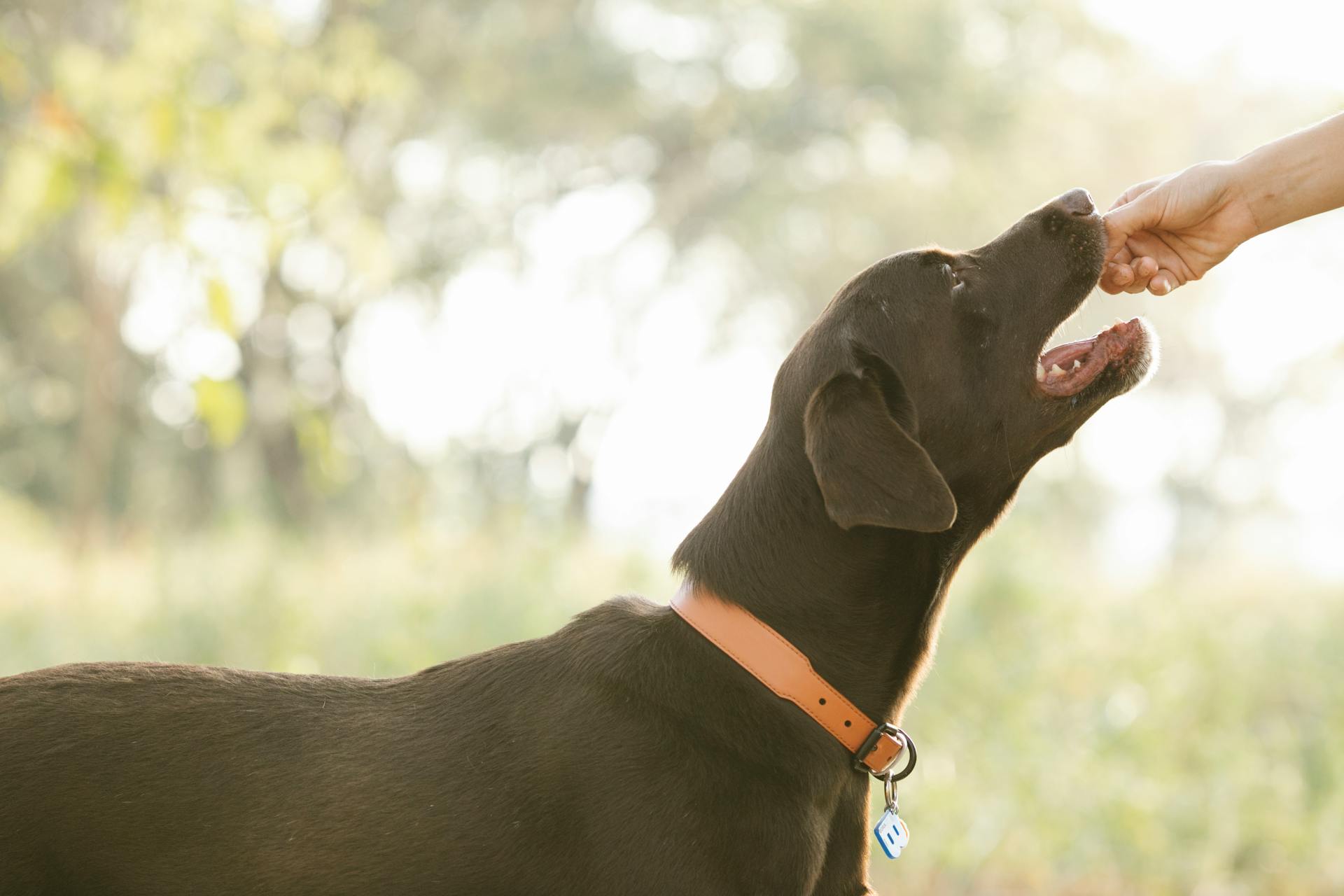
Labradors have a rich history that dates back to the 18th century in Newfoundland, Canada.
They were originally bred to assist fishermen by helping them catch fish and retrieving nets.
Labradors are a versatile breed that can thrive in various living situations, from apartments to large homes with yards.
They require regular exercise, but it's not necessary to take them on long runs or hikes every day.
Labradors are known for their friendly and outgoing personalities, making them a popular choice as family pets.
They are generally good with children, but as with any breed, it's essential to socialize them properly from an early age.
Labradors are highly intelligent and respond well to positive reinforcement training methods.
History and Origin
Labrador Retrievers hail from the island of Newfoundland, off the northeastern Atlantic coast of Canada. Their origins date back to the 1700s, where they served as companions and helpers to local fishermen.
The St. John's dogs, as they were originally called, were known for their good disposition and usefulness. They spent their days working alongside their owners, retrieving fish and towing in lines.
Many believe the St. John's dog was interbred with the Newfoundland Dog and other small local water dogs. This mix of breeds helped create the sturdy and enthusiastic helpers we know today.
The breed was first referred to as Labradors by the third Earl of Malmesbury. He imported the dogs to England in the early 1800s to serve as retrievers for hunting.
Labrador Retrievers were almost extinct by the 1880s, but thanks to the efforts of the Malmesbury family and other English fans, the breed survived. They were recognized as a distinct breed by the Kennel Club in 1903.
The breed's popularity began to take off after World War II, and in 1991, the Labrador Retriever became the most popular dog registered with the American Kennel Club.
Curious to learn more? Check out: Why Are Labradors so Popular
Physical Characteristics
Labrador Retrievers are a sturdy and athletic breed, known for their solid and muscular frame. Males typically stand between 22 to 24.5 inches at the shoulder, while females are slightly smaller.
Their weight varies between 55 to 80 pounds, reflecting their athletic build. A dense, short, and water-resistant coat helps keep them warm and dry, perfect for their original job as fishermen's assistants in cold Atlantic waters.
Their face is one of their most charming traits, with expressive eyes that seem to reflect an almost human-like understanding and kindness. Their eyes are usually a bold brown color, complemented by a broad head and a friendly, wagging tail often referred to as an 'otter' tail.
Worth a look: Lab Dog Tail
Three Little-Known Facts
Labradors have a short, easy-care coat that requires minimal grooming.
Their athletic build is a result of being built for sport, making them muscular and agile.
One of the most distinctive features of a Labrador's face is their strong nose, which is perfect for search and rescue work.
Labs are hopeless at watchdog duty, as they tend to greet intruders with a friendly demeanor and show them around the house.
Their keen intelligence makes them an ideal breed for obedience competitions, where they consistently excel.
Appearance
Labrador Retrievers are a stunning breed with a sturdy, athletic build that's perfect for their active nature. They typically stand between 22 to 24.5 inches tall at the shoulder.
Their weight varies between 55 to 80 pounds, reflecting their solid and muscular frame. This is due to their dense, short coat that's water-resistant and perfect for their original job as fishermen's assistants in cold Atlantic waters.
Their face is one of their most charming traits, with expressive eyes that seem to reflect an almost human-like understanding and kindness. These eyes are usually a bold brown color.
Their broad head and friendly, wagging tail, often referred to as an 'otter' tail, add to their endearing appearance. This tail is thick and tapering, whipping back and forth with enthusiasm.
Labradors come in three classic colors: chocolate, black, and yellow.
Health and Care
Labradors are generally healthy dogs, but like all purebreds, they can be susceptible to several genetic disorders. Regular check-ups with your vet can significantly improve the quality of life for your Labrador.
Some common health issues to watch out for include hip dysplasia, ear infections, and progressive retinal atrophy. These conditions can be managed with proper care and regular check-ups.
To keep your Labrador healthy, it's essential to keep an eye on their weight, as they can be prone to gaining a few extra pounds. Feeding them high-quality dog food that's specially formulated for a fast-growing large breed can help prevent joint disease as they develop.
Here are some common health issues that Labradors may face:
Health Needs
Labrador Retrievers are generally healthy dogs, but like all breeds, they can be prone to certain health issues. Hip dysplasia is a common problem in Labs, where the thigh bone doesn't fit properly into the hip joint.
Some other health concerns to watch out for include ear infections, obesity, heart disease, and progressive retinal atrophy (PRA). Regular check-ups with your vet can help manage these issues.

Proper care and regular exercise can significantly improve the quality of life for your Labrador. Consider wellness plans to help manage your pup's wellness and keep them healthy.
Here are some common health issues in Labrador Retrievers:
- Hip Dysplasia
- Obesity
- Ear Infections
- Heart Disease
- Progressive Retinal Atrophy (PRA)
To keep your Labrador healthy, it's essential to monitor their weight and ensure they receive the right balance of calories, protein, minerals, and vitamins. Feeding them high-quality dog food specifically formulated for large breeds can help prevent joint disease.
Care
Labrador Retrievers are highly social dogs that thrive on interaction and attention from their family. They need to be around their family and are not suited for being left alone for extended periods of time.
A lonely, bored Lab is likely to dig, chew, or engage in other destructive behaviors to burn off excess energy. Daily 30-minute walks, a romp at the dog park, or a game of fetch are great ways to help your Lab stay active and mentally stimulated.

Labradors are considered "workaholics" and will exhaust themselves if not given regular breaks. It's essential to end play and training sessions before they become too tired.
Lab puppies should not be taken on long walks and should play in short intervals to avoid straining their joints. Normal play on grass is fine, as is puppy agility with one-inch jumps.
Labradors are mouthy and love to carry something in their mouth. They're also chewers, so it's crucial to provide sturdy toys at all times to prevent damage to your belongings.
Feeding
Feeding your Labrador Retriever is crucial to their overall health and well-being. You should aim to feed them a high-quality dog food that's formulated for their current weight, age, and activity level.
Labrador Retrievers are individuals, just like people, and they don't all need the same amount of food. A highly active dog will need more than a couch potato dog, so make sure to measure their food and adjust accordingly.
Curious to learn more? Check out: Good Food for Labradors

A good rule of thumb is to feed your adult Labrador Retriever 2.5 to 3 cups of high-quality dry food a day, divided into two meals. However, this can vary depending on their size, age, build, metabolism, and activity level.
If you're unsure whether your Labrador is overweight, give them the eye test and the hands-on test. You should be able to see a waist, and with your hands on their back, you should be able to feel but not see their ribs without having to press hard.
Labrador puppies grow very rapidly between the age of four and seven months, making them susceptible to bone disorders. Feed your puppy a high-quality, low-calorie diet that keeps them from growing too fast.
Here are some general guidelines for feeding your Labrador:
- Adults: 2.5 to 3 cups of high-quality dry food a day, divided into two meals
- Puppies: High-quality, low-calorie diet that prevents rapid growth
- General rule: Follow the guidelines on the label for the amount that you should be feeding your dog
Remember, every Labrador is unique, so it's worth checking in with your vet to tailor the diet that best supports their health and keeps that tail wagging!
Temperament & Personality
Labradors are known for their sweet and outgoing personalities, making them a great breed for families and first-time owners. They're adaptable and can be gentle, but also energetic and playful.
Labradors are highly intelligent and respond well to positive reinforcement techniques like treats and praise. This makes training sessions fun and rewarding.
One of the best things about Labradors is their friendly disposition - they rarely show aggression and often wag their tails at friends and strangers alike. This makes them poor guard dogs, but excellent therapy dogs.
Labradors are also known for their loyalty and loving nature, making them great family dogs. They're easy-going and affectionate, and thrive on interaction and attention.
Here are some key traits of the Labrador breed:
- High energy levels, requiring extra attention and exercise
- Intelligent and easy to train
- Adaptable and gentle
- Loyal and loving
- Excellent with children and other pets
Overall, Labradors are a delightful breed that thrive on interaction and love being part of all family activities. They're perfect companions for homes with kids and lots of activity.
Training & Exercise
Labradors are highly energetic dogs that require a lot of exercise to stay happy and healthy. They need at least two hours of exercise daily, which can include activities like walking, running, and playing fetch.
Labradors are intelligent and eager to please, so they respond well to positive reinforcement training methods. This means using upbeat training sessions with your voice and rewarding them with treats and praise.
To keep your Labrador happy and stimulated, it's essential to provide them with mental and physical challenges. This can be achieved through activities like agility courses, puzzle toys, and interactive play. They love games like fetch, which not only provide physical exercise but also offer mental stimulation.
Labradors thrive in company and adore extra attention from their owners. If you're going to be away from your pet for a few hours, make sure to leave them stimulating dog toys and arrange for someone to check in with them.
Here are some exercise tips for Labradors:
- Provide at least 1 ½ hours of exercise per day, which should include a mix of physical activities and mental challenges.
- Include activities like walking, running, swimming, and playing fetch to keep them physically active.
- Use puzzle toys and interactive play to provide mental stimulation.
- Monitor their exercise to avoid overdoing it, especially in puppies whose joints and bones are still developing.
Labradors are natural-born swimmers and love the water, making it an excellent form of exercise for older dogs or dogs with joint issues. They also love to run and play fetch, so be prepared to provide them with plenty of opportunities for physical activity.
Remember, Labradors are adaptable and can participate in a range of activities, from hiking to agility courses. Just make sure to keep them safe and provide plenty of water and shade during hot weather.
Intriguing read: Do Labradors like Water
Grooming and Maintenance
Labradors are known for their short, smooth coats, but that doesn't mean they don't shed. In fact, they can shed a fair bit in the spring and fall, which is why regular brushing is key to managing shedding and keeping their coat shiny and healthy.
Brushing your Lab about once or twice a week is a good starting point, but during the shedding seasons, you might need to brush them daily to keep those loose hairs under control. Use a grooming glove and a metal comb to keep their coat looking its best.
Intriguing read: Why Do Labradors Shed so Much
Labradors are relatively clean dogs, but they love to roll in the mud, so they'll need a bath every now and then. Bathing them every 4-6 weeks should be enough, unless they've gotten into something particularly messy.
To keep your Lab's teeth healthy, brush them several times a week to prevent tartar buildup and gum disease. Regular nail trims are also important to prevent discomfort and ensure your Lab walks and runs comfortably.
Here's a quick rundown of what to do during your weekly grooming session:
- Brush their coat to remove loose hair
- Check their ears for signs of dirt, wax buildup, or infection
- Examine their body for parasites or skin lumps
- Brush their teeth to prevent tartar buildup and gum disease
- Trim their nails to prevent discomfort and ensure they walk and run comfortably
By following these simple steps, you'll be able to keep your Lab looking and feeling its best.
Family and Pet Compatibility
Labradors are a great match for families with kids. They love the commotion kids bring and are happy to attend birthday parties.
You should always supervise interactions between dogs and young children to prevent biting or ear or tail pulling. Teach your child never to approach a dog while they're eating or sleeping.
Labradors are also great with other pets. If they've had plenty of exposure to other dogs, cats, and small animals, they'll be friendly with them too.
It's essential to teach your children how to handle the dog respectfully, such as not riding them like a horse or pulling on their ears and tail.
If you have your children help take care of your dog, it can help instill a sense of responsibility and respect for the family pet.
Featured Images: pexels.com


